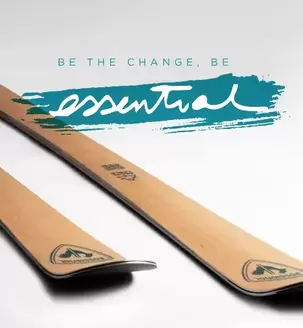
A recent article from Outside magazine details the new ski from industry mainstay, Rossignol, that is designed to be recycled as much as possible at the end of its life.
One of the main points is how Rossi is willing to share information with competitors on how they accomplished it, and for this I applaud them. It’s one of the best aspects of the outdoor industry, when companies are willing to share information they’ve invested money in producing, and could be considered a competitive advantage, but they realize that sharing it is better for people and planet by advancing sustainability.
The point that stands out to me here is how sustainability can’t just be an afterthought, it is best integrated from the design stage at the very beginning of a product’s lifecycle. It requires knowing the lifecycle of your materials inside and out, where they come from and where they can go.
They’ve also created a partnership with a recycling company, MTB, that helped in the design process and will take the skis and recycle them upon return from customers. Many times a company claims a product is recyclable because it may contain individual materials that can theoretically be recycled, but they’re joined together in a fashion that makes this impossible in the real world. Or they throw a recycling triangle on something, like styrofoam, that the average consumer thinks is then recyclable, but in reality ends up going to a landfill and may even contaminate a load of genuinely recyclable materials.
Rossignol’s website says the average ski recyclability rate is just 10%, and the Essential is at over 75%. There’s still a long way to go, but this is at least a step in the right direction.
One of the main points is how Rossi is willing to share information with competitors on how they accomplished it, and for this I applaud them. It’s one of the best aspects of the outdoor industry, when companies are willing to share information they’ve invested money in producing, and could be considered a competitive advantage, but they realize that sharing it is better for people and planet by advancing sustainability.
The point that stands out to me here is how sustainability can’t just be an afterthought, it is best integrated from the design stage at the very beginning of a product’s lifecycle. It requires knowing the lifecycle of your materials inside and out, where they come from and where they can go.
They’ve also created a partnership with a recycling company, MTB, that helped in the design process and will take the skis and recycle them upon return from customers. Many times a company claims a product is recyclable because it may contain individual materials that can theoretically be recycled, but they’re joined together in a fashion that makes this impossible in the real world. Or they throw a recycling triangle on something, like styrofoam, that the average consumer thinks is then recyclable, but in reality ends up going to a landfill and may even contaminate a load of genuinely recyclable materials.
Rossignol’s website says the average ski recyclability rate is just 10%, and the Essential is at over 75%. There’s still a long way to go, but this is at least a step in the right direction.

 RSS Feed
RSS Feed